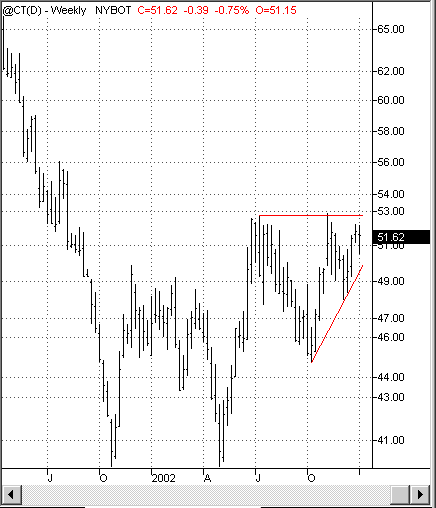
HOT TOPICS LIST
- MACD
- Fibonacci
- RSI
- Gann
- ADXR
- Stochastics
- Volume
- Triangles
- Futures
- Cycles
- Volatility
- ZIGZAG
- MESA
- Retracement
- Aroon
INDICATORS LIST
LIST OF TOPICS
PRINT THIS ARTICLE
by David Penn
Double bottom becomes cup with handle, but cotton stays high.
Position: N/A
David Penn
Technical Writer for Technical Analysis of STOCKS & COMMODITIES magazine, Working-Money.com, and Traders.com Advantage.
PRINT THIS ARTICLE
CHART ANALYSIS
Revisiting the Cotton Club Bottom
01/09/03 10:48:33 AMby David Penn
Double bottom becomes cup with handle, but cotton stays high.
Position: N/A
| Back in June 2002, I pointed out a developing double bottom in cotton futures ("It's Bottoms Up in the Cotton Club," Traders.com Advantage, June 7, 2002). While it is not necessary to refer to that article to understand this one, it is a worthwhile look at blending a long-term view on a particular market (cotton prices since 1980) with a search for present-day opportunities. The double bottom in cotton did not manifest itself well: after breaking out in the summer of 2002, cotton prices began to retrace sharply. With a breakout point at 49, cotton (basis continuous futures) rose as high as 52 before slipping back beneath the breakout level. Cotton's decline finally stopped in October at about 45. |
| While disastrous for the double bottom projection, the fact that cotton did find support around 45 and, moreover, rallied sharply back to resistance at 52 meant that a bullish stance on cotton was likely still warranted (remember that cotton in October 2001 and again in May 2002 was registering lows not seen since in the mid-1980s.) Once again, the 52 level proved to be stiff resistance for cotton bulls in November. But significantly, the subsequent November correction in cotton found a higher level of support than the correction in cotton that took place in August and September (around 48, compared to the earlier support level of 45). This, again, was a bullish indication for cotton. |

|
| Figure 1: Double bottom? Cup with handle? Ascending triangle? Any way you look at it, higher cotton prices look likely. |
| Graphic provided by: TradeStation. |
| |
| From a pattern recognition standpoint, there are two interesting scenarios for cotton based on the above price action. The first, more short-term, scenario is based on an ascending triangle that began with the "double bottom breakout" in the summer of 2002. This triangle has a horizontal resistance level at 52 and the lowermost part of the formation extends to the October low of about 45. Should the bullish case for cotton prove true, then this formation suggests an upside of 59 or more over the next few months. |
| The second, more long-term, scenario is based less on chart patterns necessarily and more on the swing rule (see my article "Livestock's Last Upswing," Traders.com Advantage, November 21, 2002). In this case, the size of the bottoming trading in cotton from the gap down in August 2001 to the current rally is added to the value at the resistance line. The swing rule, as introduced by Stan Weinstein in his "Secrets for Profiting in Bull and Bear Markets," essentially suggests that the distance from support to resistance often is the measure of any impending market move of consequence. If this sounds a little fishy, then recall that the measurement guide for such common chart patterns as head and shoulders, double bottoms/tops, and cup with handles basically involves the swing rule. Substitute "resistance" for the high point of the formation, and swap out "the neckline" for support and you can see the similarities. |
| What does the second scenario suggest by way of upside possibilities? Given that the lows in May 2002 and October 2001 reached about 40, then an upside of 64 could be reasonably anticipated. This second scenario is also the "cup with handle" scenario, with the once-upon-a-time double bottom representing the cup, with the pair of corrections and rallies (June to October correction with an October rally; November correction with a December rally) representing the handle (arguably a "double handle"). But either way, cup with handle or swing rule, the upside target of 64 is the same. |
Technical Writer for Technical Analysis of STOCKS & COMMODITIES magazine, Working-Money.com, and Traders.com Advantage.
| Title: | Technical Writer |
| Company: | Technical Analysis, Inc. |
| Address: | 4757 California Avenue SW |
| Seattle, WA 98116 | |
| Phone # for sales: | 206 938 0570 |
| Fax: | 206 938 1307 |
| Website: | www.Traders.com |
| E-mail address: | DPenn@traders.com |
Traders' Resource Links | |
| Charting the Stock Market: The Wyckoff Method -- Books | |
| Working-Money.com -- Online Trading Services | |
| Traders.com Advantage -- Online Trading Services | |
| Technical Analysis of Stocks & Commodities -- Publications and Newsletters | |
| Working Money, at Working-Money.com -- Publications and Newsletters | |
| Traders.com Advantage -- Publications and Newsletters | |
| Professional Traders Starter Kit -- Software | |
Click here for more information about our publications!
Comments
Date: 01/21/03Rank: 5Comment:

|

Request Information From Our Sponsors
- StockCharts.com, Inc.
- Candle Patterns
- Candlestick Charting Explained
- Intermarket Technical Analysis
- John Murphy on Chart Analysis
- John Murphy's Chart Pattern Recognition
- John Murphy's Market Message
- MurphyExplainsMarketAnalysis-Intermarket Analysis
- MurphyExplainsMarketAnalysis-Visual Analysis
- StockCharts.com
- Technical Analysis of the Financial Markets
- The Visual Investor
- VectorVest, Inc.
- Executive Premier Workshop
- One-Day Options Course
- OptionsPro
- Retirement Income Workshop
- Sure-Fire Trading Systems (VectorVest, Inc.)
- Trading as a Business Workshop
- VectorVest 7 EOD
- VectorVest 7 RealTime/IntraDay
- VectorVest AutoTester
- VectorVest Educational Services
- VectorVest OnLine
- VectorVest Options Analyzer
- VectorVest ProGraphics v6.0
- VectorVest ProTrader 7
- VectorVest RealTime Derby Tool
- VectorVest Simulator
- VectorVest Variator
- VectorVest Watchdog
